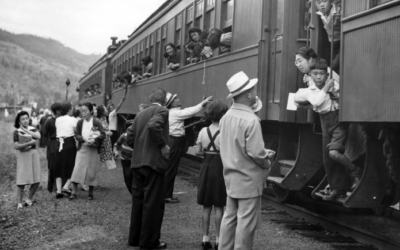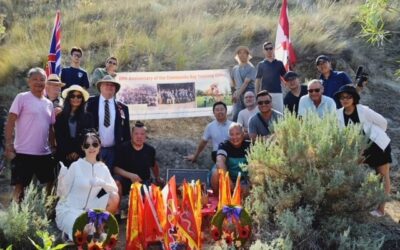The Italian Campaign saw large contingents of American, British, Canadian, and other Allied forces—both army, air units—unite to liberate Italy from Nazi German control, advancing from Sicily to the Alps. The Apennine Mountains, like a spine down the country’s length, with rivers carving valleys east and west, posed significant challenges. In late August 1944, the 5th Canadian Armoured and 1st Canadian Infantry Divisions attacked the heavily fortified Gothic Line in the Foglia Valley near Pesaro. While global attention was on the Normandy Campaign in France, these ‘D-Day Dodgers’ battled their way north through the intense Mediterranean heat.
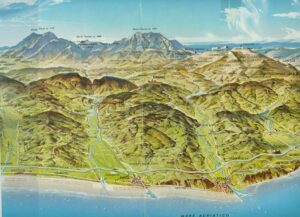
Tour guide illustration of Adriatic Sea coast near Pesaro, Italy. Marchi & Marchi Pesaro e Urbino, 1996. BCD-D-1079
Our guide is Lieutenant Zenon M. “Zeke” Ferley, the officer commanding 3rd Troop, C Squadron of the 9th Canadian Armoured Regiment (British Columbia Dragoons) of the 5th Canadian Armoured Division in Italy on August 31, 1944.
“Our regiment, the British Columbia Dragoons, was to be in the initial attack, right in the centre of the Gothic Line. It was early evening, the 30th of August 1944. My squadron leader was holding an ‘Orders Group.’ The Canadian infantry of our brigade were, at that very moment, attempting to establish two or three bridgeheads across the Foglia River. We would probably be moving into a waiting area (known as a ‘harbour’) in one of the bridgeheads early the next day. The Orders Group over, I returned to my troop and briefed them on the move [towards the Foglia]. They listened quietly, as they always did, then dispersed to make ready for a fast move out. There are never any histrionics at a time like this. The men know what lies ahead of them. When you come out of a rest period on the eve of re-entering the battle there is a great nervous excitement.”1
The next morning while the troops were stowing away their kit in and about the tanks, they waited for the order to move down into the Foglia River valley. The Honey tanks of the Reconnaissance Troop led the way, followed by the Sherman tanks of ‘A’ Squadron, ‘C’ Squadron, Regimental Headquarters Squadron (RHQ Sqn) and ‘B’ Squadron to their final objective of the day, the village of Tomba di Pesaro and Point 253.2
The road down the south side of the Foglia valley was narrow and quite windy and hilly. Progress in the dark was very slow with each driver following the tiny red ‘cats eyes’ taillights of the tank ahead. Ferley’s tank broke down so he changed to another tank and crew to carry on. Other tanks ran off the road or had mechanical problems, too. At day break C squadron was reduced to 13 out of 20 tanks and still two miles from the river crossing.
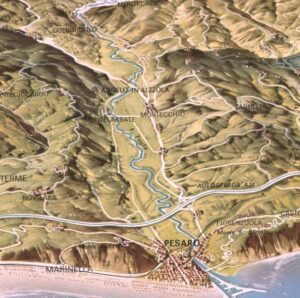
The Foglia River valley where the Canadians advanced from left to right into the Gothic Line fortifications above Montecchio, Italy August 31, 1944. Marchi & Marchi Pesaro e Urbino, 1996. BCD-B-1079
“It was clear and bright, already quite warm, and it was going to be a very hot day. The tanks were stirring up a lot of dust, as they always did on these roads. There was no concealing our approach march now. The Germans could probably see the column of dust from many miles away.”
As they reached higher ground, the landscape unfolded before them, revealing a clear view stretching several miles into the distance, directly into the Gothic Line. The terrain ahead showed the narrow Foglia River, almost dry in the summer heat, with flat, low-lying land on the far side. As expected from the intelligence maps, the Germans had cleared everything between the river and the road, leaving the area barren. Beyond the road were gentle rolling hills.
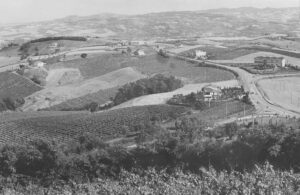
Typical rolling farmland in the Foglia Valley in 1995. BCD-P-2205
“Point 148 was almost directly across from us. I identified our harbour area beside Point 148 and it gave me the impression of a very large saucer scooped out of the hill. I looked for our infantry and their bridgeheads. Not a soul was in evidence to my sight, which was very good. I checked for vehicles: there were none. Nothing on the roads and no sign of movement anywhere. I checked for guns, anything, and saw nothing. Was our infantry really out there? Did they really have their bridgeheads? Or would we come under fire as soon as we were well out onto the flat land? I expected the Germans to be well camouflaged, under cover and virtually invisible. They always were.”
There was no time to wonder as they descended in single file through Montelabbate, across the river to carefully approach the parallel road expecting German artillery shells to fall. Reaching the far side of the river and along a narrow dirt path were little signs saying “Achtung! MINEN!” gunfire sounded ahead coming from the area of the harbour. Then the enemy artillery shelling started, and all the tanks had stopped. Shelling increased at the junction of the dirt path and the road near Montecchio becoming a fierce, cruel, and merciless torrent. The tanks ahead began to move again towards the harbour.
“There appeared to be a lot of activity up ahead and a little confusion. Things were not going as smoothly as they should. A line of German prisoners appeared, being marched back past our tanks by some of our Reconnaissance Troop soldiers. There were quite a number of them, 40 or so. Evidently, the Reconnaissance Troop and A Squadron had bumped into something at the harbour. One of our men was being carried past my tank on a stretcher. I looked down and seen [sic] that it was an officer: Lieutenant Rusty Russell. He looked in very bad shape and one of his legs seemed to be completely shattered. Quiet, pleasant Rusty . . . I wondered what had happened to him. Someone ahead was directing our squadron off the road into the harbour area. I turned my tank left and followed the tanks ahead through the path which had been cleared through some mines.”
Radio orders came through telling C Squadron to press on through A Squadron’s position to the ridge line to the north of the harbour area without stopping as anticipated. Their objective was Point 204 about 1 to 1 ½ miles ahead. The tanks churned their way forward to ‘hull down’ positions with just the gun showing over the ridge. Careful examination of the ground showed it was undulating and irregular going up a major slope ahead.
“From this point on, I have no idea what happened to A and B Squadrons that day. For the remainder of the day, I personally never seen (sic) any of their tanks, nor did I see any of our infantry. I presumed from the general plan that one of our squadrons (probably A) would be coming up on our left, and the other squadron (B) would be held in reserve. What lay ahead of us was our main concern. Despite all the noise [from enemy shelling], everything still seemed very quiet and still to me. I knew the Germans were out there somewhere waiting for us and I knew that they would probably get the first crack at us. They were well hidden, and we were not. A usual situation.”
Ferley could see part of a copse of trees beyond a ridge that was Point 204, and beyond that the high ground of Hill 253 near Tomba di Pesaro. His first action was to attack a camouflaged anti-tank gun under a tree to his front with H.E. [High Explosive] rounds.

